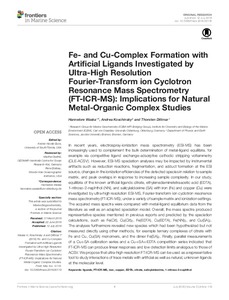| dc.contributor.author | Waska, Hannelore | |
| dc.contributor.author | Koschinsky, Andrea | |
| dc.contributor.author | Dittmar, Thorsten | |
| dc.date.accessioned | 2019-01-08T15:54:51Z | |
| dc.date.available | 2019-01-08T15:54:51Z | |
| dc.date.issued | 2016 | |
| dc.identifier.citation | Waska, H.; Koschinsky, A. and Dittmar, T. (2016) Fe- and Cu-Complex Formation with Artificial Ligands Investigated by Ultra-High Resolution Fourier-Transform ion Cyclotron Resonance Mass Spectrometry (FT-ICR-MS): Implications for Natural Metal-Organic Complex Studies. Frontiers in Marine Science, 3, Article 119, 19pp. DOI: 10.3389/fmars.2016.00119 | en_US |
| dc.identifier.uri | http://hdl.handle.net/11329/638 | |
| dc.identifier.uri | http://dx.doi.org/10.25607/OBP-197 | |
| dc.description.abstract | In recent years, electrospray-ionization mass spectrometry (ESI-MS) has been increasingly used to complement the bulk determination of metal-ligand equilibria, for example via competitive ligand exchange-adsorptive cathodic stripping voltammetry (CLE-ACSV). However, ESI-MS speciation analyses may be impacted by instrumental artifacts such as reduction reactions, fragmentation, and adduct formation at the ESI source, changes in the ionization efficiencies of the detected species in relation to sample matrix, and peak overlaps in response to increasing sample complexity. In our study, equilibria of the known artificial ligands citrate, ethylenediaminetetraacetic acid (EDTA), 1-nitroso-2-naphthol (NN), and salicylaldoxime (SA) with iron (Fe) and copper (Cu) were investigated by ultra-high resolution ESI-MS, Fourier-transform ion cyclotron resonance mass spectrometry (FT-ICR-MS), under a variety of sample matrix and ionization settings. The acquired mass spectra were compared with metal-ligand equilibrium data from the literature as well as an adapted speciation model. Overall, the mass spectra produced representative species mentioned in previous reports and predicted by the speciation calculations, such as Fe(Cit), Cu(Cit)2, Fe(EDTA), Cu(EDTA), Fe(NN)3, and Cu(SA)2. The analyses furthermore revealed new species which had been hypothesized but not measured directly using other methods, for example ternary complexes of citrate with Fe and Cu, Cu(SA) monomers, and the dimer Fe(SA)2. Finally, parallel measurements of a Cu+SA calibration series and a Cu+SA+EDTA competition series indicated that FT-ICR-MS can produce linear responses and low detection limits analogous to those of ACSV. We propose that ultra-high resolution FT-ICR-MS can be used as a representative tool to study interactions of trace metals with artificial as well as natural, unknown ligands at the molecular level. | en_US |
| dc.language.iso | en | en_US |
| dc.rights | Attribution 4.0 | * |
| dc.rights.uri | http://creativecommons.org/licenses/by/4.0/ | * |
| dc.subject.other | Organic ligands | en_US |
| dc.subject.other | FT-ICR-MS | en_US |
| dc.subject.other | Iron | en_US |
| dc.subject.other | Copper | en_US |
| dc.subject.other | EDTA | en_US |
| dc.subject.other | Citrate | en_US |
| dc.subject.other | Salicylaldoxime | en_US |
| dc.subject.other | 1-nitroso-2-naphthol | en_US |
| dc.title | Fe- and Cu-Complex Formation with Artificial Ligands Investigated by Ultra-High Resolution Fourier-Transform ion Cyclotron Resonance Mass Spectrometry (FT-ICR-MS): Implications for Natural Metal-Organic Complex Studies. | en_US |
| dc.type | Journal Contribution | en_US |
| dc.description.refereed | Refereed | en_US |
| dc.format.pagerange | 19pp. | en_US |
| dc.identifier.doi | 10.3389/fmars.2016.00119 | |
| dc.subject.parameterDiscipline | Parameter Discipline::Chemical oceanography::Metal and metalloid concentrations | en_US |
| dc.subject.instrumentType | Instrument Type Vocabulary::mass spectrometers | en_US |
| dc.bibliographicCitation.title | Frontiers in Marine Science | en_US |
| dc.bibliographicCitation.volume | 3 | en_US |
| dc.bibliographicCitation.issue | Article 119 | en_US |
| dc.description.bptype | Best Practice | en_US |
| dc.description.bptype | Standard Operating Procedure | en_US |
| dc.description.frontiers | 2016-03-31 | |
| obps.contact.contactemail | hannelore.waska@uni-oldenburg.de | |
| obps.resourceurl.publisher | https://www.frontiersin.org/articles/10.3389/fmars.2016.00119/full | en_US |
 Repository of community practices in Ocean Research, Applications and Data/Information Management
Repository of community practices in Ocean Research, Applications and Data/Information Management

